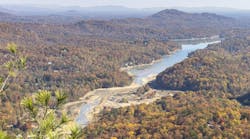Campus Designers Look to Underground Solutions
Texas’ Comal Independent School District needed to make several major renovations and additions to the existing New Braunfels Canyon High School campus due to area population growth.
The existing campus sits along the I-35 northbound frontage road, where the value of the land surrounding the campus continues to increase, even in a depressed economy. One of the main challenges that the design engineer, Gil Civil Engineering, had to consider was the best utilization of this land. Staff needed to provide the necessary parking required for the campus and surrounding sports facilities.
Gil Civil Engineering worked with CONTECH’s storm water specialists to provide an underground detention system (UGDS) design.
The Limited Land Test
Most commonly, design engineers utilize large onsite detention ponds in which storm water runoff can be stored and then discharged at predevelopment rates. This solution can be cost-effective when the value of the land is low and the design engineer has a large site with which to work.
However, this was not the case with the New Braunfels Canyon High School site. With the increasing value of the land along the I-35 frontage road, Gil Civil Engineering turned to CONTECH Construction Products Inc. to offer the most feasible solution to address the storm water detention requirements.
In addition to the high cost of the surrounding land, the project posed a number of other challenges:
- The site was extremely flat, without much fall for a conventional storm drain system to discharge storm water into the Texas Department of Transportation’s existing box culverts.
- A standard detention pond would have needed to be rather large, running along the length of the school building, and would have limited access to the building.
- A detention pond close to the school would have posed a potential safety hazard to the students, plus a health hazard as a potential breeding ground for mosquitoes.
- A detention pond close to the school would have been very unsightly.
The long-term cost benefits make UGDS systems a viable alternative.
UGDS Solution
Gil Civil Engineering worked with CONTECH’s storm water specialists to provide an underground detention system (UGDS) design consisting of roughly 9,000 ln ft of 42-in.-diameter Aluminized Type 2 corrugated steel pipe (CSP). The solution did the following:
- Created additional usable space by designing a parking lot on top of the UGDS;
- Eliminated the safety and health hazards of a detention pond;
- Improved campus beautification with the elimination of the detention pond; and
- Provided long-term cost benefits by eliminating the need for ongoing maintenance (i.e., mowing, regrading and possible removal of silt and sand material that a detention pond would have required).
A UGDS proved to be the most cost-effective and beneficial system for New Braunfels Canyon High School, and the school can expect an estimated 75-year service life with the Aluminized Type 2 CSP product chosen for the UGDS.
While UGDS systems typically cost more to install than traditional detention ponds, the long-term cost benefits make them a viable alternative.

